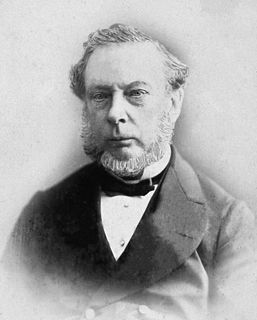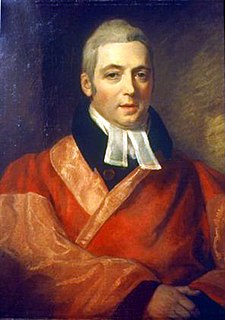
George Pinckard M.D. (1768–1835) was an English physician, known as an author, an abolitionist, and in the field of insurance. [1]

George Pinckard M.D. (1768–1835) was an English physician, known as an author, an abolitionist, and in the field of insurance. [1]
The son of Henry Pinckard of Handley Hall, Northamptonshire, he was tutored by a clerical relative, studied medicine first at the then united hospitals of St. Thomas's and Guy's, then at Edinburgh, and finally at Leyden, where he graduated M.D. on 20 June 1792. He resided afterwards for a short time with his brother and sister at Copet, near Geneva, and witnessed the capture of the city by the French forces under General Montesquieu. [2]
On 30 September 1794 Pinckard was admitted a licentiate of the College of Physicians of London. In October 1795 he was appointed a physician to the forces, and accompanied Sir Ralph Abercromby's expedition to the West Indies. He was on the Santo Domingo staff, and had numerous delays before starting, during which he made the acquaintance of James Lind, then in charge of Haslar Hospital. He reached Barbados in February 1796. [2]
Pinckard was in Ireland during the Irish Rebellion of 1798, and served on the staff of General Samuel Hulse. He was promoted for his services to the rank of deputy inspector-general of hospitals, and had part of the direction of the medical service in the Duke of York's expedition to Den Helder. On his return he took a house in Great Russell Street, then moved to Bloomsbury Square, London, and resided there till his death. He established the Bloomsbury Dispensary, and was physician to it for thirty years. [2] In 1823 he formulated the idea of insuring lives beyond the normal bounds, from a medical standpoint, leading to the foundation in 1824 of Clerical Medical. [3] He was chairman and a director from its foundation in 1824 to his death in 1835. [4] [2]
Pinckard suffered from angina pectoris, and died while writing a prescription for a patient in his consulting-room on 15 May 1835. [2]
In his Notes on the West Indies (3 vols. 1806; 2nd ed. 2 vols. 1816), Pinckard described his experiences in the West Indies and Guiana, particularly of slavery. [2] Passages from this work were reprinted by abolitionists in 1807. [5] In 1808 he published Dr. Pinckard's Case of Hydrophobia, from Chipping Barnet in Hertfordshire. He subsequently published in the London Medical Journal two other cases of hydrophobia, and reprinted all three, with another, in a pamphlet entitled Cases of Hydrophobia (1819), dedicated to John Latham. In April 1835 he published Suggestions for restoring the Moral Character and the Industrious Habits of the Poor; also for establishing District Work-farms in place of Parish Workhouses, and for reducing the Poor-rates. He recommended farms laid out for the purpose by the spade-labour of paupers. [2]
![]() This article incorporates text from a publication now in the public domain : Lee, Sidney, ed. (1896). "Pinckard, George". Dictionary of National Biography . 45. London: Smith, Elder & Co.
This article incorporates text from a publication now in the public domain : Lee, Sidney, ed. (1896). "Pinckard, George". Dictionary of National Biography . 45. London: Smith, Elder & Co.

CaesarHenry Hawkins FRS was a British surgeon.
Archibald Robertson was a Scottish physician and medical author who had a notable naval career, followed by a long private practice.

The Royal London Hospital for Integrated Medicine is a specialist alternative medicine hospital located in London, England and a part of University College London Hospitals NHS Foundation Trust. It is the largest public sector provider of complementary medicine in Europe. It is based in the Bloomsbury area of Central London, adjacent to Great Ormond Street Hospital.

Frederic Hervey Foster Quin was the first homeopathic physician in England.

Robert Jackson M.D. (1750–1827) was a Scottish physician-surgeon, reformer, and inspector-general of army hospitals.

Jesse Foot was an English surgeon and biographer.

Clerical Medical is a British life insurance, pensions and investments company founded in 1824, and a subsidiary of Lloyds Banking Group.

Richard Pearson was an English physician and medical writer.

John Haslam (1764–1844) was an English apothecary, physician and medical writer, known for his work on mental illness. Haslam's case study of James Tilly Matthews is the earliest detailed description of paranoid schizophrenia.

Thomas Bevill Peacock was a cardiologist in London remembered for founding the London Chest Hospital. He also made a large contribution to the understanding of aortic dissection by publishing several case series on the condition.
John Rollo M.D. was a Scottish military surgeon, now known for his work on a diabetic diet. Rollo was the first to suggest a low-carbohydrate diet as a treatment for diabetes.

James Ormiston McWilliam (1808–1862) was a Scottish naval surgeon, physician and writer on infectious diseases, best known as medical officer to the 1841 Niger expedition.

George Leith Roupell M.D. FRS (1797–1854) was an English physician.

Caleb Hillier Parry was an Anglo-Welsh physician credited with the first report of Parry–Romberg syndrome, published in 1815, and one of the earliest descriptions of the exophthalmic goiter, published in 1825.
Sir George Leman Tuthill (1772–1835) was an English physician.

William George Maton M.D. was an English physician, a society doctor who became associated with the British royal family. He published on natural history and antiquarian topics.

Sir George Edward Paget, was an English physician and academic.
George Lipscomb (1773–1846) was an English physician and antiquarian, known particularly for his county history of Buckinghamshire.

William Stephen Gilly (1789–1855) was an English cleric and author, known for his support of the Waldensian Church.
The Bloomsbury Dispensary for the Relief of the Sick Poor was an institution founded in 1801 to provide medical aid and suitable nourishment to the poor people of Bloomsbury.